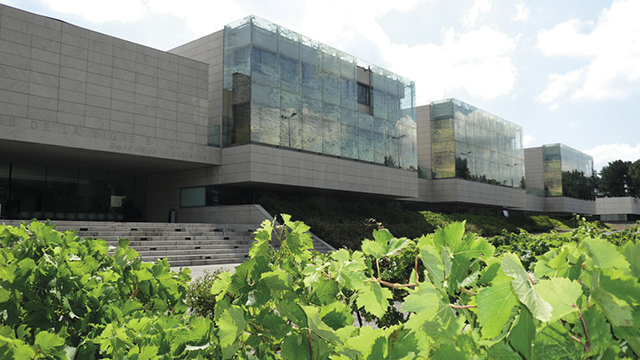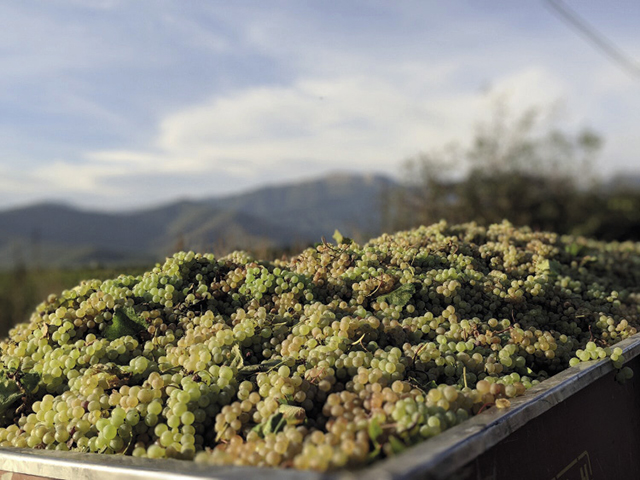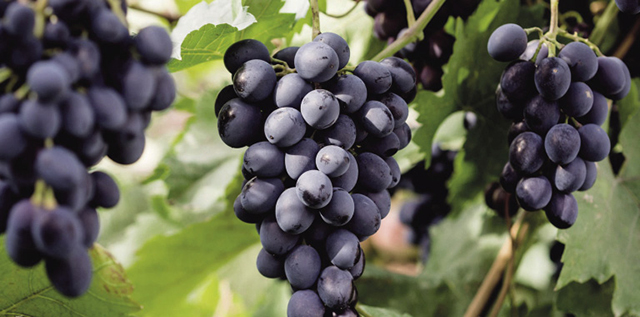Climate change is posing a challenge to vintners around the globe, who are experimenting with the hardiness of Georgian grape varieties to respond to rising temperatures and increased sun exposure
Originally published on Investor.ge.
There’s one thing that unites us with grapes: we’re both extremely prone to sunburn. Earlier just one of the many issues faced by grape farmers, climate change is now making this vulnerability a major concern in vineyards from Europe to Australia and North America. Excess sun can cause sugar content in grapes to spike and thus raise potential alcohol content when vinified.
International interest in Georgia’s two main grape varieties, Rkatsiteli and Saperavi, has thus peaked in recent years. Both have developed tough skins as a result of their thousands of years of development and hard history, and they both seem relatively unfazed by the sun. They have good track records, too, on disease resistance and in the drier and less predictable weather cycles that are upsetting grape chemistry amidst climate change.
Trial growing of both Georgian varieties to test their all-round climate-change resilience – not just to the sun – is ongoing in France, Italy, Australia and the US (although a few vineyards in the two latter countries had previously discovered Saperavi’s capacity to make high quality wine). Right now, though, what growers and winemakers are seeking globally are hardy varieties to help them adapt their vineyards and enable them to stay in business despite extreme weather. These new weather patterns encompass record temperatures, destructive unexpected frosts, hail storms and high winds.

And Georgia’s vine pool seems to have still more to offer. While these two leading varieties grow well in the wide diversity of conditions seen across Georgia’s climate zones, there is also a long list of other Georgian vines that have adapted successfully to conditions prevailing in specific locales, as detailed in the Italian-funded report Georgian Grapevine Cultivars: Ancient Biodiversity for Future Viticulture. These range, for example, from Tsolikouri in Svaneti and Imereti, to Takveri in South Kartli and Chkhaveri in Guria. Nearly 40 Georgian grape cultivars are currently recommended for wine production, but further studies are in progress to enable more to be recognized as invaluable sources of biodiversity.
Two European research programs, GrapeGen06 and COST Action FA1003, in collaboration with a strong and active network of European-Georgian scientists, have worked on genetically characterizing and preserving Georgian genetic resources of wine.
“All the outcomes about the genetic characterization” of Georgian vines showed “uniqueness and originality of this germplasm when compared to the European and Central Asian germplasm,” say Georgian Cultivars’ authors. And the varieties from different regions of Georgia were not only different but maintained their originality when grown elsewhere. Since diversity is a “major source of crop improvement and adaptation of changing environmental conditions,” the report states, Georgia’s vines provide an excellent “foundation for any breeding program.”
Wine companies (and oenophiles) have been reading with horror the growing pile of gloomy reports on what lies ahead as temperatures mount (France had its earliest harvest in 500 years in 2020, and Australia the hottest summer on record).
Newspaper headlines around the world have, over recent months, picked on the nub of the potential crisis: “Global heating may lead to wine shortage – a rise of 2°C would cause 56% loss of vineyard land, while 4°C would wipe out 85%,” “Wine regions face dramatic shrink with climate change,” “Climate change threatens world wine supply,” and “Goodbye Cabernet Sauvignon: How climate change will end wine as we know it.”
Vitis vinifera, the common grape, does best where the average temperature sits between 13°C and 21°C, but growers have been pushing the species to its limits for millennia, with excellent results. Quality wines have emerged from such disparate places as North Africa, the Swiss alpine slopes, and even cool, wet England.
“The wine grape is the most valuable crop on the planet. It’s also remarkably prodigious. There are at least 6,000 varieties of Vitis vinifera, with previously undocumented cultivars (varieties produced by selective breeding) being identified all the time. But despite this, only a dozen or so – mainly French – grapes make up 80% of wine on the global market, and many are simply not fit to withstand warmer, drier climates. Varieties such as Merlot, Chardonnay, Pinot and Cabernet dominate vineyards from Napa to New Zealand, despite the climatic differences and the cultivars’ French ancestry. But these grapes were never meant to be grown everywhere,” comments US science and technology magazine Wired.
While scientists have been drawing attention to these looming problems for some time, it is only in the last couple of years that crises in the vineyards have driven growers en masse to wake up to their warnings. Work published as far back as 2000 by Professor Hans Reiner Schultz, a viticulture scientist at Germany’s Geisenheim University with experience advising winegrowers across four continents, contradicted the formerly prevailing belief that a hotter, drier climate always makes better wine. He pointed out that “elevated levels of ultraviolet B rays are transforming grape composition” and “upsetting the metabolites responsible for giving grapes their flavor.”

For regions where results suggest that cultivar diversity may be most critical, growers must choose to actively shift varieties, which requires overcoming legal and cultural hurdles
In the French wine region of Bordeaux, which makes $4 billion in annual wine sales, hotter and longer summers were at first welcomed with vintage after vintage producing fabulous wines. “But then 2017 happened. A freak late-April frost devastated the crop, and production in Bordeaux crashed by 295 million bottles,” Wired noted. This destroyed 40% of the crop, with the worst hit variety being the sensitive Merlot.
Most widely read of all the vine and climate change-related research papers has been one published in the online journal Nature Climate Change from Dr. Elizabeth Wolkovich, an ecologist at the University of British Columbia, who wrote a report with colleagues as far back as ten years ago to describe how climate change posed serious challenges for wine growers. Recent record high temperatures across the world, plus the soaring incidence of fires in vineyard regions, are now bringing this issue into focus. As she notes in the paper: “With continued warming, it may be hard to continue growing grapes in some regions.”
She continued: “Wine producers’ increasing reliance on a few major varieties translates into a global market that is investing in an increasingly limited portfolio at exactly the time when a large diversity of varieties is most needed. This narrow focus means a narrower range of critical traits related to climate, which in turn reduces the flexibility of most vineyards to adapt to climate change.”
Through research on European vineyards, she and her colleagues found that harvest time there was now coming two to three weeks earlier than during the 1980s. Every stage of the vine growth cycle has been shifting, from budburst to ripening, opening vineyards to vulnerabilities like frost and drought. These conditions trickle down into taste, aroma, alcohol content and general wine quality.
That paper re-opened a debate that has been growing in the wine world for the past decade, expanding on the idea that a great redrawing of wine maps was needed. Wolkovich says attention should be paid to the many regional varieties that have been pushed into obscurity by global wine trends. Yet, while diversification is seen as the only long-term solution, even this “will save only 42% if temperatures rise as much as four degrees,” according to Ignacio Morales-Castilla at Spain’s University of Alcala.
One vineyard exploring new vine varieties and possible diversification, sited at the University of Bordeaux’s Science Institute of Vine and Wine Bordeaux Sciences Agro project, VitApt, has over 50 different vines in its vineyard. The professor in charge, Cornelis van Leeuwen, told Wired: “We are just going back to the common sense that people have used for ages, and in many cases have forgotten as growers jumped on the Cabernet-Pinot-Merlot-Chardonnay bandwagon.” Common sense, he said, was understanding the differences between later and earlier ripening varieties. The ones found in their trials to be most at risk from warmer, drier climates were early ripening ones, including the top European favorites of Pinot Noir, Chardonnay and Sauvignon Blanc.
Now that each season seems to bring weather that used to cause once-in-a-generation disasters, science and new tech are being called on to help care for vines and to maintain the necessary acid and sugar balance of the grapes. While diversification is constantly referred to as a solution, in tightly regulated countries such as France, bringing in non-traditional foreign or even local grape varieties is frowned upon (particularly by France’s Institut National de l’Origine de la Qualite), so there is pressure to change the rules. There is also the problem of introducing consumers to new grape varieties.

Researchers in Wolkovich’s team foresee late ripening varieties such as Syrah, Grenache and Mourvedre becoming more widespread in Europe and the Pacific Northwest. Most of the classics in Napa Valley and Sonoma, including Cabernet Sauvignon, Pinot and Merlot, would be all right with a two-degree rise in temperature, they believed, but in South Africa they would be lost. Vineyards in hot countries such as Italy and Spain would suffer the most. While growers may move vines to higher or north-facing locations to avoid the worst of the sun, the problem is then the colder night-time temperatures, and a high location brings with it different levels of precipitation.
Wolkovich acknowledged that a growers’ life will be far from easy: “For regions where our results suggest that cultivar diversity may be most critical, growers must choose to actively shift varieties, which requires overcoming legal and cultural hurdles. Currently, traditional practices, alongside regulations at local, regional, and higher levels, limit how much and where growers can shift varieties easily. This, coupled with other considerations, such as the temporal and related financial cost of replanting or regrafting a vineyard, may lead many growers to prefer alternative options that keep a particular variety tied to a region. For example, local management practices to reduce microclimatic temperatures or adjust the pace of development (e.g., shade cloth, reduced leaf area to fruit weight ratio, or longer-cycle rootstocks) may help some growers, but generally work best for lower amounts of warming, especially compared to changing varieties.”
Wine producers’ increasing reliance on a few major varieties translates into a global market that is investing in an increasingly limited portfolio at exactly the time when a large diversity of varieties is most needed
Among those seeing Saperavi vines as a solution is one major vineyard in Italy, where the climate is becoming more tropical. Castello Banfi in Tuscany told UK magazine Drinks Business that Saperavi was part of its search for grapes that are “resistant to botrytis, thick skinned and lower flowering,” which “makes them more durable and able to thrive in Tuscany without being sprayed with artificial chemicals; they can weather the region’s intensifying heat and sunlight over the next few decades.” Trials are being carried out and once the grapes ripen, they are vinified in small batches so the end result can be assessed by researchers.
Various reasons have been put forward for the resilience of Georgian vines, and their relative mildew, fungus, disease and climate resistance compared to commonly planted European varieties. The Italian-Georgian team that researched Georgian Grapevine Cultivars: Ancient Biodiversity for Future Viticulture, funded by the University of Milan and the National Wine Agency of Georgia as part of ongoing research to help Georgian farmers and build the status of Georgian wines, credit the long history of development: in the South Caucasus it was 8,000 years ago that humans “started with the conscious or unconscious selection of desirable phenotypical traits.” There have also been the benefits of bi-directional gene flow between wild and cultivated vines, “a relatively recent event occurring over the last few hundred years [that] led to the birth of so-called anthropic crosses, with the aim of satisfying specific requirements.” It has helped, too, that research in Soviet times focused on developing Saperavi and Rkatsiteli for vineyards across all of Georgia’s climate zones.
The report states that Georgia’s “geographical features strongly characterize the climate of its 12 wine-growing regions with “profoundly different conditions, ranging from hot continental summer to warm continental summer.” There is “high variability in the plant phenology among Georgian cultivars, both in sprouting date and in the ripening period…” with a large degree of adaptability: “a delayed budburst perhaps representing an avoidance mechanism against spring frosts.” Usefully, the Georgian varieties have been found “not to change their characteristics when grown internationally.”

In Europe, more work is being carried out to help solve some of the wine growers’ problems, and recently €3.4 billion was allocated by the EU from its environment budget to help build software models to show the impact of climate change globally at vineyard level. The New Zealand-based project director, Herve Quenol, told the trade magazine Wine Business International that data on how climate change was affecting vines was being combined with regional climate change studies. Their aim is to build software models to enable vintners to make informed choices on what to plant and how to manage their vineyards.
In Australia’s Queensland winegrowing region, Sirromet Wines’ chief winemaker and viticulture director Mike Hayes is among those who have been introducing Saperavi as the country struggles with months of droughts. “Many regions are now dabbling in emerging varieties for climate change and we will see a huge increase in their plantings,” he told the Sydney Morning Herald.
“If we don’t become new farmers, we will perish. The industry has to change. It’s quite a controversial issue, but deep down, most in the industry know it’s accurate.”
As Wired comments: “The wine industry has faced crises before, and it has adapted.” It is this history, more than anything else, that gives scientists such as Van Leeuwen “reason for hope.”
In the 19th century, he points out, “the Phylloxera aphid, which feeds on the roots and leaves of most kinds of Vitis vinifera grapes, devastated much of the European, and particularly the French, wine industry. The sector eventually rebounded, but only after a global network of botanists and growers joined forces to counter the threat.” The multi-national trials with Georgian vines are striving to repeat history.

By Sally White for Investor.ge














